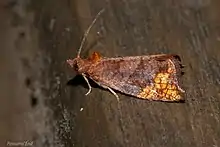| Pyrgotis eudorana | |
|---|---|
 | |
| Female | |
 | |
| Male | |
| Scientific classification | |
| Domain: | Eukaryota |
| Kingdom: | Animalia |
| Phylum: | Arthropoda |
| Class: | Insecta |
| Order: | Lepidoptera |
| Family: | Tortricidae |
| Genus: | Pyrgotis |
| Species: | P. eudorana |
| Binomial name | |
| Pyrgotis eudorana | |
Pyrgotis eudorana is a species of moth of the family Tortricidae. It is endemic in New Zealand and has been observed in both the North and South Islands. However it is regarded as a rare insect. This species inhabits native forest. Larvae exclusively feed on Muehlenbeckia australis and adults are on the wing from November to April. Adults are attracted to light.
Taxonomy
.jpg.webp)
This species was first described by Edward Meyrick in 1885 using a female specimen collected at New Plymouth in February.[2][3] Later that year Meyrick gave a more detailed description of the species.[4] Meyrick, in 1911, described the male of the species.[5] In 1928 George Hudson discussed and illustrated this species in his publication The butterflies and moths of New Zealand.[6] In both 1971 and again in 1988 J. S. Dugdale confirmed the placement of this species within the genus Pyrgotis.[7][3] The female holotype specimen is held at the Natural History Museum, London.[3]
Description
Meyrick described the adult female of this species as follows:
Female.—20 mm. Head, palpi, and thorax purplish-ochreous. Antennae ochreous-whitish. Abdomen and legs yellow-whitish, anterior and middle pair suffused with reddish-fuscous. Forewings broad, oblong, costa anteriorly very strongly arched, apex round-pointed, produced, hindmargin strongly sinuate, hardly oblique; purplish-ochreous, obscurely strigulated with greyish-purple; a slightly darker purplish basal patch, its outer edge extending from 1⁄5 of costa to 2⁄5 of inner margin, not angulated; central fascia straight, broad throughout, greyish purple, suffused with bright reddish-ochreous on upper half posteriorly, running from middle of costa to anal angle; a more distinct strigula from 3⁄4 of costa to hindmargin below middle: cilia rather dark fuscous purplish. Hindwings yellow-whitish, towards apex more yellowish, somewhat spotted with pale grey towards inner margin; cilia yellow-whitish. A handsome species, readily known by the different form of wing, straight outline of basal patch, and broad central fascia; the costa is very much more strongly arched anteriorly than in any other species.[4]
In 1911 Meyrick described the adult male of the species as follows:
♂. 18mm. Head and thorax reddish-ochreous-fuscous, thoracic crest ferruginous-ochreous. Antennal ciliations 1. Abdomen whitish-grey, anal tuft ochreous-whitish. Forewings rather elongate-triangular, costa gently arched, with moderate costal fold reaching 2⁄5, apex obtuse, termen slightly sinuate, somewhat oblique; fuscous-purplish indistinctly strigulated with dark grey; costal fold brownish-ochreous strigulated with grey; a triangular apical ochreous-orange patch, marked with some dark-fuscous strigulae between veins and on costa, its anterior edge straight, running from 3⁄5 of costa to tornus; central fascia indicated as an evenly broad band of darker suffusion preceding this: cilia reddish-ochreous-fuscous. Hindwings pale grey, apical half ochreous-whitish; cilia ochreous-whitis, on lower half of termen basally spotted with light grey.[5]
Distribution
This species is endemic to New Zealand.[8] It has been observed in both the North and South Islands at locations such as Taranaki, Lake Horowhenua, Kaitoki, Wellington, and Dunedin.[6][9] It is regarded as being rare.[6][10]
Habitat
This species inhabits native forest.[6]
Behaviour
Adults of this species are on the wing in November to April with the species appearing to be most abundant in December.[6][11] This species has been collected via a black light trap.[10]
Host species
_Meisn._(AM_AK359802-3).jpg.webp)
P. eudorana larvae feed exclusively on Muehlenbeckia australis.[7]
References
- ↑ "Pyrgotis species". www.tortricidae.com. Todd Gilligan. Retrieved 16 January 2017.
- ↑ Edward Meyrick (1885). "Tortricina (supplementary). Additions to former paper. Abstract". New Zealand Journal of Science. 2: 148. Wikidata Q110920520.
- 1 2 3 John Stewart Dugdale (23 September 1988). "Lepidoptera - annotated catalogue, and keys to family-group taxa". Fauna of New Zealand. Department of Scientific and Industrial Research. 14: 172. doi:10.7931/J2/FNZ.14. ISSN 0111-5383. Wikidata Q45083134.
- 1 2 Edward Meyrick (May 1885). "Art. XIII. — Descriptions of New Zealand Micro-Lepidoptera". Transactions and Proceedings of the New Zealand Institute. 17: 143. ISSN 1176-6158. Wikidata Q110920492.
- 1 2 E. Meyrick (1 July 1911). "Notes and Descriptions of New Zealand Lepidoptera". Transactions and Proceedings of the New Zealand Institute. 43: 62. ISSN 1176-6158. Wikidata Q58200989.
- 1 2 3 4 5 George Vernon Hudson (1928), The butterflies and moths of New Zealand, Illustrator: George Hudson, Wellington: Ferguson and Osborn Limited, p. 219, LCCN 88133764, OCLC 25449322, Wikidata Q58593286
- 1 2 Dugdale, J. S. (10 November 1971). "Entomology of the Aucklands and other islands south of New Zealand: Lepidoptera, excluding non-crambine Pyralidae" (PDF). Pacific Insects Monographs. 27: 164. ISSN 0078-7515. Wikidata Q64006453.
- ↑ "Pyrgotis eudorana Meyrick, 1885". www.nzor.org.nz. Landcare Research New Zealand Ltd. Retrieved 16 January 2017.
- ↑ "Pyrgotis eudorana Meyrick, 1885". www.gbif.org. Retrieved 2022-02-15.
- 1 2 T. H. Davies (January 1973). "LIST OF LEPIDOPTERA COLLECTED IN AREAS SURROUNDING HASTINGS AND NAPIER" (PDF). New Zealand Entomologist. 5 (2): 208. doi:10.1080/00779962.1973.9723002. ISSN 0077-9962. Wikidata Q54755566. Archived from the original (PDF) on 9 February 2013.
- ↑ "Pyrgotis eudorana". iNaturalist. Retrieved 2022-02-15.